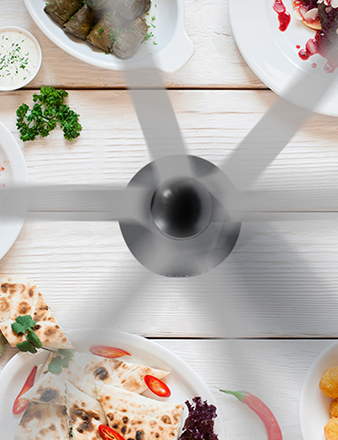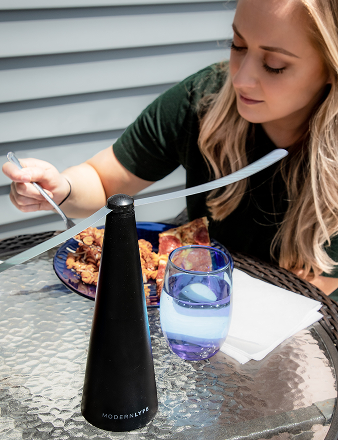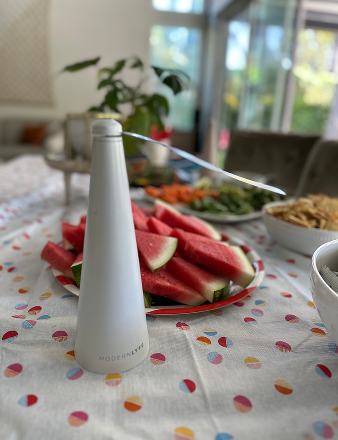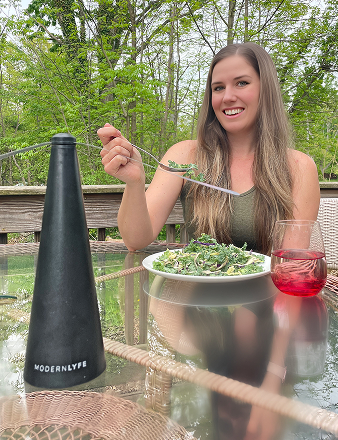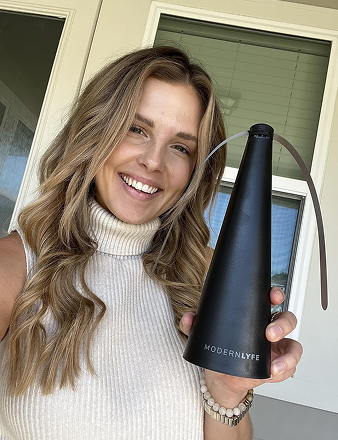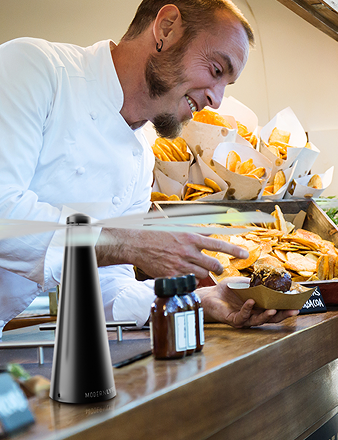You're trying to enjoy an afternoon on the deck, but that incessant buzzing is driving you crazy. It's a scene we all know too well, and it's time to end it.
This guide is about taking back your outdoor space for good. We’ll show you how a solid outdoor fly repeller can turn your backyard from a fly-infested headache into the peaceful oasis you want. Forget swatting and spraying; let's find a real, lasting solution.
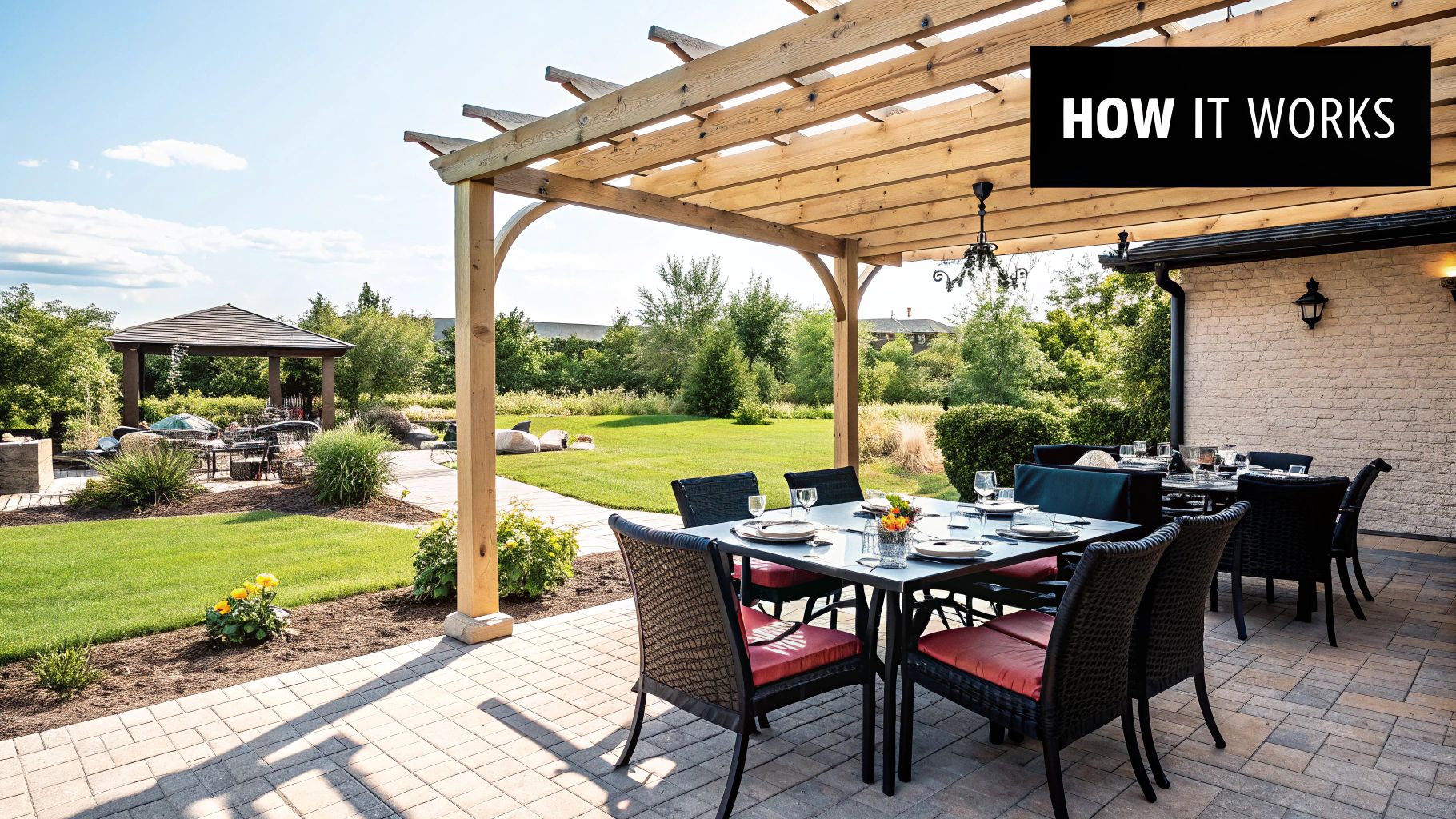
Why Old-School Methods Don't Cut It
For years, we've relied on fly swatters and sticky traps. Sure, a well-aimed swat offers a moment of victory, but you're just reacting. You’re only dealing with the flies that have already crashed your party.
A dedicated outdoor fly repeller is different. It’s proactive. It works to keep flies from ever becoming a problem, either by luring them away from your space or by setting up a barrier they won't cross. This means you can finally focus on your guests and the grill, not on playing defense against insects.
The Real Problem With Flies
Let's be direct: flies are more than just annoying. They're disgusting and pose real hygiene risks. A single housefly can carry over 1 million bacteria. They travel from garbage cans, compost piles, and pet waste right before landing on your potato salad. A swatter can't solve that health risk.
Here's what you're really up against:
- Health Hazards: They are notorious for spreading germs and contaminating food.
- Non-Stop Annoyance: Constant buzzing can ruin any conversation or quiet moment.
- Uncomfortable Guests: Nobody wants to eat or relax while fending off pests. It kills the vibe.
An effective outdoor fly repeller doesn't just reduce the buzz; it creates a cleaner, safer environment for you, your family, and your guests.
Ultimately, getting rid of flies is about reclaiming your comfort and peace of mind. By understanding the different tools available—from silent ultrasonic devices to powerful bait systems—you can pick the right one for your yard. This guide will walk you through everything you need to know to make the best choice and finally enjoy your outdoor space.
How Different Outdoor Fly Repellers Actually Work
To win the war against flies, you need to understand the weapons at your disposal. Outdoor fly repellers aren't magic—they're clever devices that use a fly's biology against it. They work by making an area unpleasant for flies, luring them into a trap, or blocking them physically.
Knowing how each type functions is the key to picking the right one for your backyard. Let's break down the science behind the most common methods.
The Science of Repulsion: Electronic Methods
Some of the most popular modern options are electronic repellers. These gadgets create an invisible barrier that flies hate but humans and pets barely notice.
One of the slickest technologies is the ultrasonic outdoor fly repeller. Think of it as a silent, high-pitched alarm that only pests can hear. It emits sound waves at a frequency too high for our ears, but for a fly, it's an overwhelming, irritating noise. This creates a "sonic fence" they instinctively avoid.
Then there are fly fans. It’s a surprisingly simple but effective concept that exploits a fly's biggest weakness: they're terrible flyers. The gentle breeze from the fan blades creates enough turbulence to make it impossible for them to navigate or land on your food. It’s like creating a mini windstorm right over your picnic table.
The Mechanics of Chemical Deterrents
Another classic strategy is fighting flies with smells they can't stand. Chemical-based repellers release specific scents into the air that effectively tell flies to "keep out."
The most common tools here are diffusers or sprays that use essential oils. These aren't just for pleasant aromas; many plants produce these oils as a natural defense. Research shows that compounds in citronella, lemongrass, peppermint, and eucalyptus are fantastic at overwhelming a fly's sensitive sense of smell, making your patio the last place they want to be.
It's like putting up an invisible, scented "no-fly zone." You might enjoy the fresh smell, but to a fly, it’s a blaring warning sign to find an easier meal somewhere else.
This image highlights the key differences between various repeller types, from their coverage to their environmental impact.
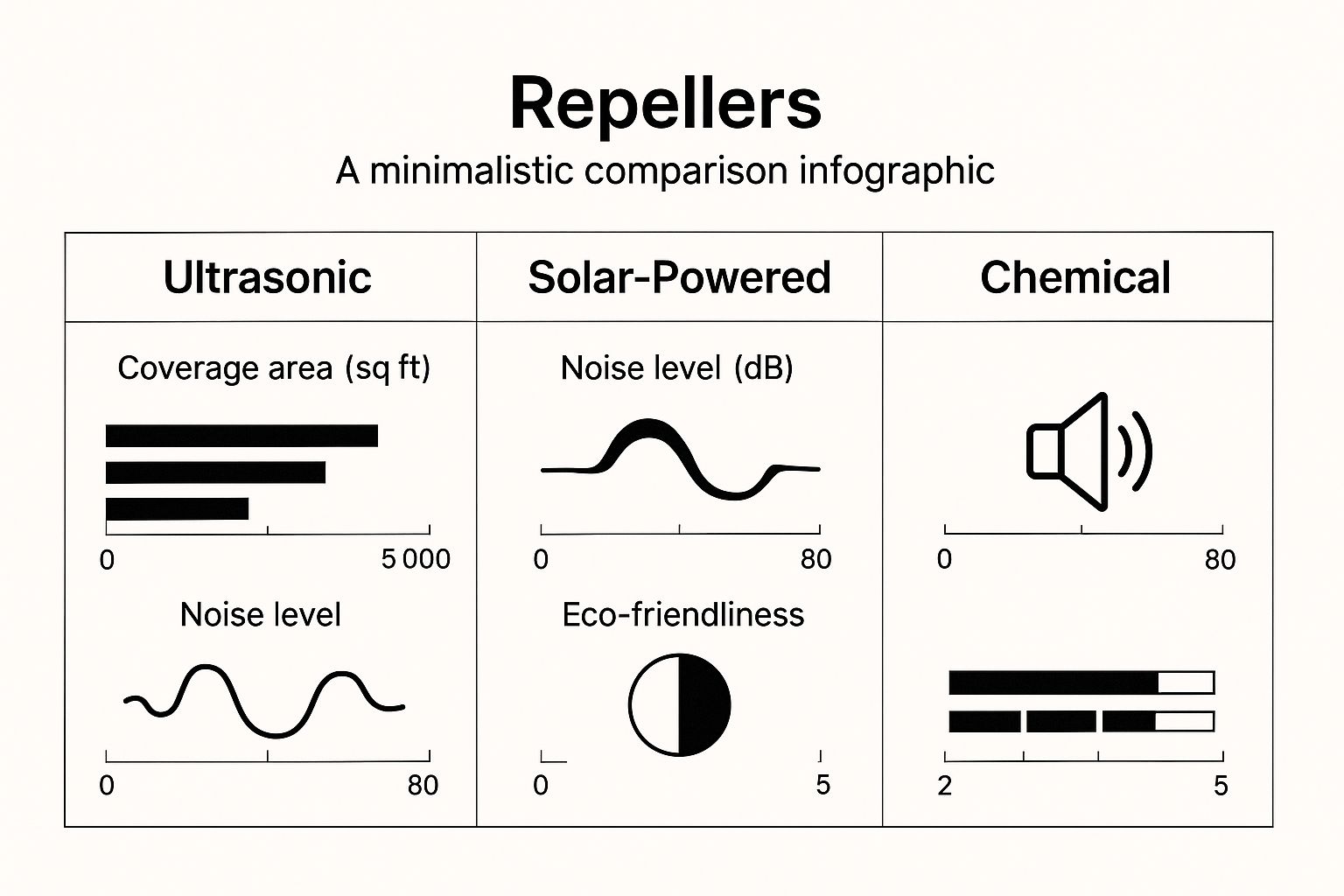
As you can see, you might trade the quiet, eco-friendly operation of ultrasonic models for the broader scent-based coverage of a chemical diffuser.
Understanding Physical Traps and Zappers
Sometimes, repelling flies isn't enough—you need to actively reduce their numbers. That's where traps and zappers come in. These devices don't just create a barrier; they attract flies and take them out of the equation for good.
Here’s a quick rundown of how they work:
- Bait Traps: These are like a Trojan horse for flies. They use a powerful attractant—usually something sweet or pungent—to lure flies inside a container they can't escape.
- UV Light Zappers: Picture a bug nightclub with a deadly bouncer. These devices use a bright ultraviolet (UV) light that many flying insects find irresistible. When they fly in to investigate, they make contact with a high-voltage electrical grid. Zap.
- Sticky Traps: This is the most straightforward method. It’s simply a surface coated with an incredibly sticky, non-drying glue. Often paired with a color or scent to attract flies, it traps them the moment they land.
To make the choice clearer, here’s a table comparing these different approaches.
Comparing Outdoor Fly Repeller Technologies
Each fly control technology has its own strengths and is best suited for different situations. This table breaks down the core differences to help you find the right fit for your yard.
| Repeller Type | How It Works | Typical Effective Range | Best For |
|---|---|---|---|
| Ultrasonic Repeller | Emits high-frequency sound waves that irritate and deter flies. | 15-30 feet from the device. | Patios, decks, and seating areas where a silent, invisible barrier is needed. |
| Fly Fan | Creates air turbulence, making it difficult for flies to land. | 4-6 feet in diameter per fan. | Protecting tables during outdoor meals and gatherings. |
| Chemical Diffuser | Releases scents from essential oils (like citronella) that repel flies. | 10-20 feet in a radius, depending on wind. | Creating a broad "no-fly zone" around patios, pools, or garden areas. |
| Bait Trap | Lures flies in with a potent attractant and traps them inside. | Attracts from 30+ feet away. | Placing away from living areas to draw flies away and reduce the local population. |
| UV Zapper | Attracts light-sensitive insects with a UV bulb and eliminates them on an electric grid. | Attracts from 50+ feet away. | Perimeter control, especially at night, to reduce overall insect numbers. |
| Sticky Trap | Uses a sticky adhesive (sometimes with a scent or visual lure) to trap flies on contact. | A few feet. | Targeted problem spots like near trash cans, compost bins, or doorways. |
The best defense is a good offense. Electronic and chemical options are fantastic for creating a protective bubble around your space, while traps and zappers actively work to thin the herd. Understanding these differences is the first step to enjoying a fly-free summer.
How to Choose the Right Outdoor Fly Repeller
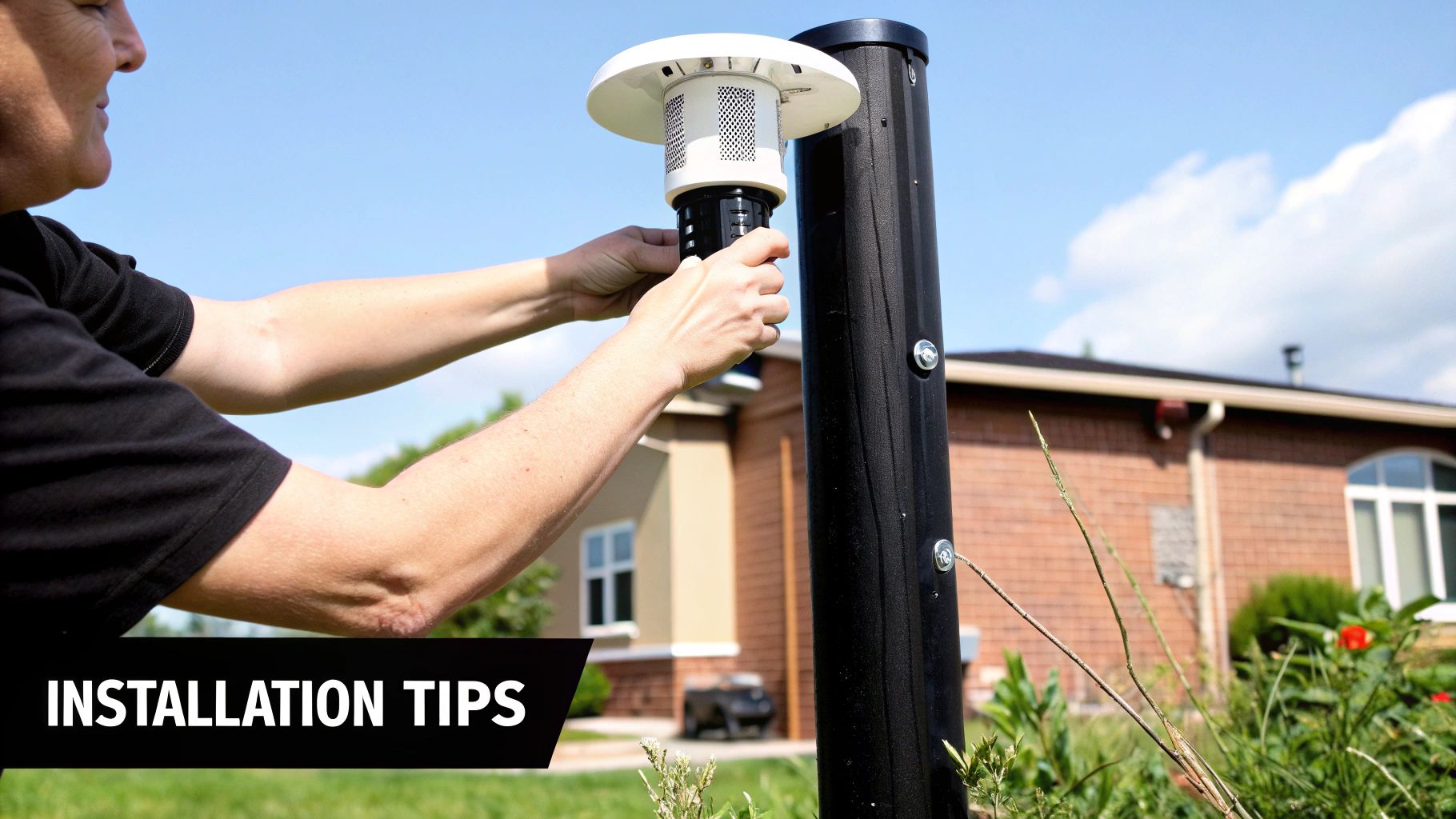
Now that you know how these gadgets work, it's time to pick the perfect tool for your space. Choosing an outdoor fly repeller isn't a one-size-fits-all deal. What works for a small balcony will be useless on a sprawling backyard patio.
Think of it like a strategy game. You need to consider your environment, who uses it (including pets!), and how much maintenance you're willing to do. This way, you'll land on a solution that makes your life easier, not one that just looks good in the box.
Assess Your Coverage Area
First things first: how much space are you trying to protect? This is the most important part of the puzzle. A small, portable fly fan might be the hero of your two-person bistro table, but it won't stand a chance against a 500-square-foot deck.
Measure your space. Manufacturers almost always list an "effective range" or "coverage area" in square feet. Use this number as your guide.
- Small Spaces (Under 150 sq. ft.): This is your typical balcony, small porch, or cozy seating area. A portable fly fan, a tabletop diffuser, or a single ultrasonic device should do the trick.
- Medium Spaces (150-400 sq. ft.): Think standard patios and decks. Here, you might need a more powerful diffuser, a few ultrasonic units creating a perimeter, or a combo strategy—like a fan on the table and a zapper at the edge of the yard.
- Large Spaces (Over 400 sq. ft.): For big backyards or pool areas, you need to layer your defenses. This often means placing powerful bait traps far from guests to draw flies out of the main area, then using zappers or diffusers closer to where people gather.
Consider Power Source and Portability
Next up: how will you power it? Not every backyard has convenient outlets right where you need them.
Think about how you'll actually use the device. Do you need something you can easily move from the grill to the dining table? Or are you looking for a permanent, set-it-and-forget-it installation?
Your power source dictates placement. A battery-operated or solar-powered repeller offers total freedom, while a plug-in model provides consistent power but tethers you to an outlet.
Here's a quick rundown of the most common options:
| Power Source | Best For | Key Advantage | Main Drawback |
|---|---|---|---|
| Battery-Operated | Tabletops, picnics, temporary setups | Maximum portability and flexibility. | Requires regular battery changes or recharging. |
| Plug-In (Electric) | Permanent installations on patios with outlets | Consistent, reliable power without worry. | Limited by cord length and outlet availability. |
| Solar-Powered | Garden areas, yard perimeters | Eco-friendly and no running costs. | Effectiveness can depend on daily sunlight. |
Factor in Safety for Kids and Pets
If you have curious kids or four-legged family members, safety is a top priority. It's crucial to understand that some fly repellers are safer than others.
Chemical-based products, even some essential oil diffusers, can be toxic if ingested or cause skin irritation. Always check the active ingredients. And UV zappers can get hot and use a high-voltage grid, making them a hazard if placed where little hands can reach.
For households with kids and pets, these are your safest bets:
- Fly Fans: These are often the best choice. Their soft blades are designed to stop on contact, creating a simple air barrier without chemicals or heat.
- Ultrasonic Devices: These are generally considered safe because the sound frequency is outside the hearing range of humans and most common pets like dogs and cats.
- Non-Toxic Bait Traps: As long as they're placed up high or where kids and pets can't reach them, these are a safe way to lure flies away.
Keeping flies off your food is a huge part of this. For more great ideas, check out our guide on how to keep flies away from food when you're eating outside.
Evaluate Maintenance Requirements
Finally, be honest about upkeep. An outdoor fly repeller only works if you take care of it. Some require daily attention, while others can be left alone for weeks. For most busy people, a low-maintenance option is the one that will actually get used.
The demand for these solutions is exploding. The insect repellent market is projected to grow from USD 6.1 billion in 2025 to USD 11.7 billion by 2035. This surge is all about people wanting effective, convenient products—especially eco-friendly and natural options that feel safer for their families. Picking the right device for your life isn't just buying a gadget; it's investing in a solution that fits this modern approach to pest control.
Where You Put It Matters: A Guide to Smart Placement
So you’ve got your new fly repeller. Great. But before you just plop it down on the nearest table, understand this: where you place your device is just as important as which one you bought. Getting the placement right is the secret to creating a truly fly-free zone.
Think of it like setting up speakers for an outdoor party. You wouldn’t stick them in a random corner. You’d place them strategically for the best sound experience. The same logic applies here. You have to think like a fly to outsmart one.
First, Create a Protective Perimeter
Your main goal is to shield the spots where people hang out—the patio table, the grill, the chairs. Don't just put one repeller in the middle. A better strategy is to set up a defensive perimeter around your main space.
This works wonders for devices that release a scent or use ultrasonic waves. By setting up a few units around the edges of your deck or patio, you’re building an invisible wall. This keeps flies from ever getting close, which is more effective than fighting them off once they're already buzzing around your food.
The best defense is a good offense. Don't wait for flies to show up—create a barrier that ensures they never get an invitation.
By setting up a perimeter, you’re telling flies the party is happening somewhere else, leaving your central gathering area peaceful and pest-free.
Go with the Flow: Use Wind to Your Advantage
The wind is a game-changer that people almost always forget. If your repeller releases a scent, like a Thermacell or citronella diffuser, wind direction is everything. If you place it downwind from where you're sitting, you're just sending all that protective vapor to your neighbor’s yard.
Always check which way the breeze is blowing and place your diffuser upwind. That way, the natural airflow will carry the repellent across your entire space and create the shield you're looking for.
Even with scent-free devices, you can make the air work for you.
- Tabletop Fly Fans: Place these directly on the dining table. Flies are clumsy fliers, and the constant air movement makes it nearly impossible for them to land on your food.
- Larger Oscillating Fans: For a bigger seating area, a well-placed oscillating fan can disrupt fly flight paths over a much wider space and keep your guests cool.
Know When to Lure and When to Repel
Not all repellers should be kept close. The right placement depends entirely on what the device is designed to do: attract flies or keep them away. Mixing these up is a recipe for disaster.
It's simple: divide them into two camps.
-
"Lure Away" Devices (Bait Traps, UV Zappers): These are fly magnets by design. Putting one next to your grill is like hanging a "Free Food Here!" sign for every fly in the neighborhood. Place these traps far away from people, at least 20-30 feet from your main area, ideally at the edge of your property.
-
"Keep Away" Devices (Diffusers, Fans, Ultrasonics): These create your personal protective bubble. They need to be close to the action to work. A diffuser is most effective within 10-15 feet of your chairs, and a fly fan needs to be right on the table to create that disruptive airflow.
Once you get these basic placement rules down, you’ll see a massive difference. Your fly repeller will go from being just another gadget to your secret weapon for a perfect, pest-free evening.
Keeping Your Repeller in Top Working Condition
You’ve set up your new outdoor fly repeller and are finally enjoying a pest-free patio. To keep that fly-free zone going all season, a little upkeep goes a long way.
Think of it like any other tool—a quick check-in ensures it’s always ready to perform at its best. This isn't complicated, just a few minutes of care that will extend the life of your device and keep it working like a charm.
Routine Checks for Every Repeller Type
Every type of fly repeller has its own needs, but a simple maintenance routine is universal. A quick look-over every week or two can catch small issues before they turn into a full-blown fly invasion.
Here’s a simple breakdown of what to watch for:
- UV Zappers: The electric grid is the heart of the machine. Unplug the unit, then use a small, dry brush to clear away any insect debris. A clogged grid is less effective and can be a safety issue.
- Bait Stations: The lure brings the flies in. Check the bait level weekly and top it off according to the manufacturer’s directions. Fresh bait is potent bait.
- Chemical Diffusers: These gadgets depend on repellent pads or liquid cartridges. Keep an eye on them, because they're useless once the repellent is gone.
- Fly Fans: For battery-powered models, consistent power is everything. We dive deeper into this in our complete guide to fly repellent fans, which has great tips on maximizing their performance.
Troubleshooting Common Performance Issues
Has your once-mighty fly repeller started to lose its punch? Don't panic. The solution is usually simple. A sudden drop in performance often boils down to one of a few easy fixes.
Before you write the device off as broken, run through a quick mental checklist.
It's easy to overlook the obvious. In my experience, 80% of performance issues are caused by basic maintenance slip-ups—like dead batteries, an empty bait trap, or a clogged grid—not a faulty device.
For instance, if your UV zapper isn't attracting as many insects, the bulb is the likely culprit. UV bulbs lose their ability to attract insects long before they burn out, so it's a good habit to replace them at the start of each season.
Keeping Your Investment Protected
A few minutes of maintenance is a small price to pay for seasons of fly-free comfort. The global market for fly repellents is on a major upswing, projected to grow from USD 3.96 billion in 2024 to nearly USD 6 billion by 2030. This shows how much people value reliable, long-lasting solutions. For more on this, check out the analysis of the growing fly spray market on ResearchAndMarkets.com.
By taking good care of your outdoor fly repeller, you’re ensuring it remains a trusted ally for years, keeping your outdoor spaces clean, comfortable, and blissfully pest-free.
Creating an Integrated Fly Control System
Sometimes, even the best outdoor fly repeller can feel like it’s fighting a losing battle. The secret to winning isn't one magic device; it’s building a layered defense. When you combine your repeller with a few smart tactics, you can make your yard a place where flies just don't want to hang out.
An integrated approach makes your space less appealing to pests from the start, supercharging the work your repeller is already doing. It's all about rolling up the "welcome" mat so flies don't even show up.

Start with Simple Housekeeping
The most powerful fly deterrent is often the most basic one: keeping things clean. Flies are on a constant mission to find food and places to lay eggs, and a messy yard is a five-star resort for them. The goal is to shut down those opportunities before they become an issue.
Make a huge difference right away by focusing on these key spots:
- Secure Your Trash: Make sure every outdoor trash can has a tight-fitting lid. An open bin is a fly magnet.
- Manage Pet Waste: If you have pets, scoop their waste regularly. It's a major food source and breeding ground for flies.
- Clean Up Spills: That spilled soda or dropped burger patty? Clean it up immediately. Even tiny messes can bring dozens of flies in minutes.
Think of your repeller as your security guard. Basic housekeeping is like locking the doors and windows. When you do both, you create a much stronger defense.
This simple cleanup routine removes the main reasons flies are drawn to your yard, forcing them to move on.
Eliminate Breeding Grounds
Besides food, flies need standing water to lay their eggs. A single fly can lay hundreds of them, so getting rid of these nurseries is critical for controlling the population.
Do a quick walk-around your property and dump out any stagnant water. Check for clogged gutters, old buckets, birdbaths (refresh every other day), and the saucers under your potted plants. A dry yard is a dead-end for the next generation of flies.
Harness the Power of Natural Deterrents
For a final layer of defense, add some plants that flies naturally hate. Many common herbs give off essential oils that act as repellents. Planting them around your patio or in deck containers creates a barrier that's as beautiful as it is functional.
Consider adding a few pots of these fly-repelling plants:
- Basil
- Mint
- Lavender
- Rosemary
- Lemongrass
This multi-pronged strategy is becoming more popular as people look for smarter ways to handle pests. The global market for fly control products, including the outdoor fly repeller category, was valued at USD 294.1 million in 2025 and is on track to nearly double by 2035. This trend shows a clear move toward combining hygiene with pest management. You can learn more about the trends in the fly trap market on FutureMarketInsights.com.
By pairing your repeller with good sanitation, smart water management, and natural deterrents, you build a powerful system that makes your outdoor space a no-fly zone.
Got Questions? We've Got Answers
Even after digging into the details, you probably have a few practical questions. Let's clear up some of the most common things people ask before choosing an outdoor fly repeller.
Are These Things Safe Around My Kids and Pets?
This is the first question on everyone's mind. The short answer is: it depends on the type.
Match the device to your family’s situation. Chemical-free options are almost always the safest route.
- Ultrasonic Devices: Generally, these are perfectly safe. They produce a high-frequency sound that we can't hear, and neither can pets like dogs and cats.
- UV Zappers: These don't use chemicals, but their high-voltage grid gets hot and can be a burn or shock risk. You must place them high up, well out of reach of curious hands or paws.
- Chemical Repellents: Read the label. Twice. Many contain chemicals or essential oils that can be harmful if ingested, especially for cats. Always place them where they can’t be licked, chewed, or knocked over.
When in doubt, think simple. A basic fly fan just uses moving air to keep flies away. It's often the most worry-free solution for households with kids and pets.
How Quickly Will I See Results?
When flies are dive-bombing your barbecue, you want relief now. How long you have to wait depends on how the device works.
Repellers that create a "no-fly zone"—like diffusers or ultrasonic models—start establishing their barrier almost immediately. You'll likely notice a difference within a few minutes to an hour.
On the other hand, traps that lure flies in take more time. They need a while to attract the pests, so it might be several hours or even a full day before you see a real drop in the fly population.
Can I Just Use My Indoor Repeller Outside?
It’s tempting to grab that little plug-in from the kitchen and stick it on the patio, but that’s a bad move. There are two big reasons why: safety and power.
First, indoor electronics aren't built for the outdoors. They have no protection against rain, dew, or humidity, which creates a serious electrical hazard.
Second, they just aren't strong enough. An indoor gadget is designed for a small, contained room. In the wide-open outdoors, with wind and endless space, its effect will be completely lost. For more ideas on pest-proofing your yard, check out our guide on how to keep flies away outside. Always use a product specifically built and rated for outdoor conditions.
Ready to reclaim your patio with a stylish, effective, and safe solution? The fly fans from MODERN LYFE create a gentle, fly-free zone perfect for any outdoor meal or event. Explore our collection at https://modernlyfe.com and enjoy your outdoor space again.

